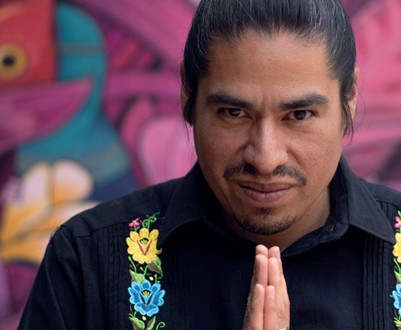

He is one of the most influential artists of the urban art movement in Mexico and Latin America. His work integrates elements of traditional muralism with contemporary art and graffiti, creating a visual language that connects with our traditions.
What began as a hobby, soon became his life, the best way to express himself. Edgar Flores, better known as “Saner”, began drawing at the age of 4, without knowing that this would be his profession.
“Graffiti appeared in my life during high school. Studying graphic design is the best decision I could have made, thanks to it, I discovered street art and how to create discourse through graphics”.
Why “Saner”, what does it mean?
I was looking for a name for the graffiti and wanted to give a meaning to the play of letters. I was inspired by the word “sanar” in English, as I found it interesting how the irony of such a chaotic world could be seen as something that makes you feel alive. It’s a reflection on how in a world of madmen, a “sane” person is something unusual.
What is your creative process like, what inspires you to execute your work?
The first thing I do is to analyze what platform I’m going to use and what materials I’m going to work with. It’s not the same to create a piece for an institution as for a single space. Each support has its own language, whether it’s a notebook, a tennis shoe or a wall. The process begins with the research of the support, the history of the piece and the conceptualization. Then I start looking for references, signs and forms that complement the concept. My work usually has several stages: sketching, execution and a reflection on the concept I am working on. In many projects there is a B-side and a C-side, as each piece always has more than one interpretation.
How do you define your art, what do you seek to convey with it?
My art is born out of an identity crisis. In my adolescence, I was influenced by styles from other places and I wondered what defined me. It was then that I found the first dance masks, which allowed me to connect with Mexicanness and see the world from my perspective. In 2006, when I asked myself what I wanted to do, I decided to do something that reflected my identity, my traditions, but without falling into the typical. My work is a reinterpretation of Mexicanity, decontextualizing dances and flavors, and always looking for ways to deconstruct what we already know. When I left Mexico, dialogues emerged about identity and how my work grew by combining traditional elements with international influences
What does muralism and the history of the great Mexican artists mean to you?
It has been a great inspiration for me, especially the graphic and conceptual part of the muralist school. Having the opportunity to show my work in museums like MUNAL, alongside artists like Tamayo, has been an honor. I’ve admired their work since I was little, from the bills and textbooks to seeing their murals live and understanding the magnitude of what they did.
What work do you think best represents you?
One of my favorites is the mural at the Museum of Popular Cultures, which has become part of Mexico’s heritage. There is also the Reforma mural at the Reforma Hotel, one of the most emblematic pieces in the city, done in 2012. Another important work was the mural in Australia, which exceeded my expectations, and one more in Orleans, Paris.
How do you define Mexico through your work?
Mexico is for me a dream: a place where everything is possible, both the logical and the illogical. It is the place where dreams can come true, but also where your worst nightmares can come true. In my works, I try to capture that duality and the complexity of the country.
What has been your greatest learning since you started in this profession?
I have learned that constant evolution and learning are key. It’s not just about making art, it’s about understanding the contexts, the stories and the people around you. Each stage of my career has taught me something new about myself and the world I live in.
What do you do to promote this art?
I try to be a reference for the new generations, offering workshops and sharing my experience. It’s important to give them tools so they can express themselves and understand graffiti as a legitimate form of art, not just vandalism.
What graffiti works in Mexico would you recommend not to miss?
There are many talented artists in Mexico, and each one has his or her own unique style. Among those I would recommend is the work of artists such as DR. Lakra, Cix, and Smithe, who are leaving an important mark on Mexican graffiti
And receive exclusive information to travel through Mexico in style!